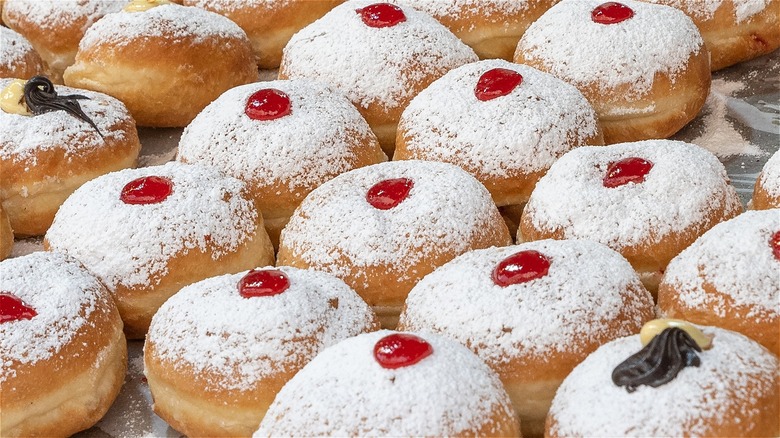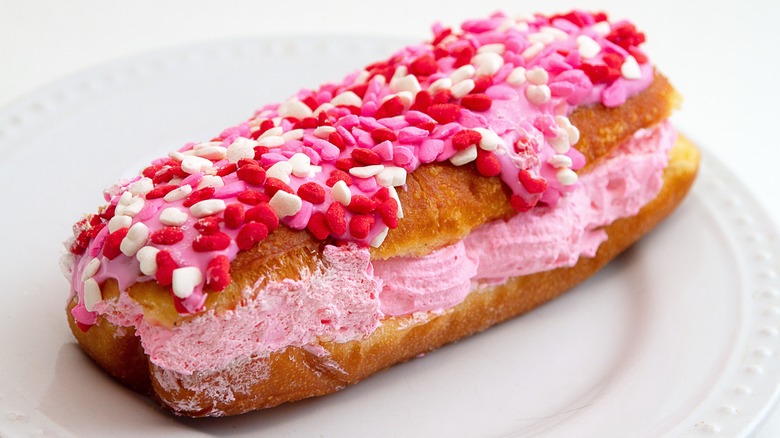What Is A Bismark Donut, And What Does It Taste Like?
Is there ever a bad time for a donut? They're tasty whether you eat them with your morning coffee or for a late night dessert. With seemingly infinite combinations of fillings, toppings, and shapes, it's sometimes easier to order by saying "I want the purple frosted one." But be sure to remember the name Bismark.
The Bismark is one of the fanciest of the donut varieties, though it can be confused with other kinds such as Bavarian creams. Not limited to a single shape, it can be round or rectangular. The latter case translates into more dough, more filling, and more to snack on. It comes with a variety of filling and topping options, and can often resemble an éclair both in shape and flavor when filled with cream and topped with chocolate. The pastry tastes like a classic airy donut made with yeasted dough while the filling can be jelly- or cream-based. Given the delicious possibilities that come together in a single sweet package, it's no wonder that the Bismark has become a classic found in bakeries and donut shops all over the United States.
What exactly is a Bismark donut?
The Bismark donut can be traced to jelly donuts that originated in Germany before becoming popular in other parts of the world. The story goes that a German solider turned baker in the 1800's would fry his pastries since there were no ovens, and his fellow soldiers called them Berliners after his hometown. Around 1900, the donuts were also known as Bismarken, a reference to German chancellor Otto von Bismarck, hence the modern name. It is a yeasted donut, meaning the dough is leavened with yeast, and comes in many different styles. Most are filled, though it's not a requirement. They may contain raspberry lemon jelly or even Bavarian cream — but note that the latter option doesn't make it a classic Bavarian cream donut. Those are typically coated in sugar after they're fried. Meanwhile, toppings for Bismarks include chocolate or vanilla icing, whipped cream, or powdered or cinnamon sugar.
The style in which the Bismark is made depends on region. For example, in Southern states, the Bismark may actually be known as a Long John — for its rectangular shape — and might simply have a sugary topping and no filling. The Berliner version of this donut is actually round. Note that you may also see it called Bismarck with a "c" in the name — there's no difference in ingredients, it is simply a difference in the spelling.
What sets the Bismark apart
Some Bismarks can be hard to distinguish from other similar donuts. For instance, if you see a round version that's glazed with chocolate and filled with Bavarian cream, it will resemble its Boston cream counterpart. But don't be fooled. Modeled after the classic Boston cream pie, Boston cream donuts have a smooth vanilla custard filling. In other cases, the Bismark may stand out more easily with a little help.
When they are rectangular, Bismarks provide more surface area to be decorated. At establishments like Dunkin', the donuts are used to make "fancies" which are filled with a fruit jelly, frosted with vanilla buttercream, and topped with sprinkles. When celebrating holidays, you can change up the decorations. This also applies to making Bismark donuts at home: You can alternate toppings and fillings to create your perfect combo that may not be served in store. You can also follow other tips for making the best donuts, like having a game plan for your fillings, so your homemade Bismark creations taste like they've come straight from the pastry case.


